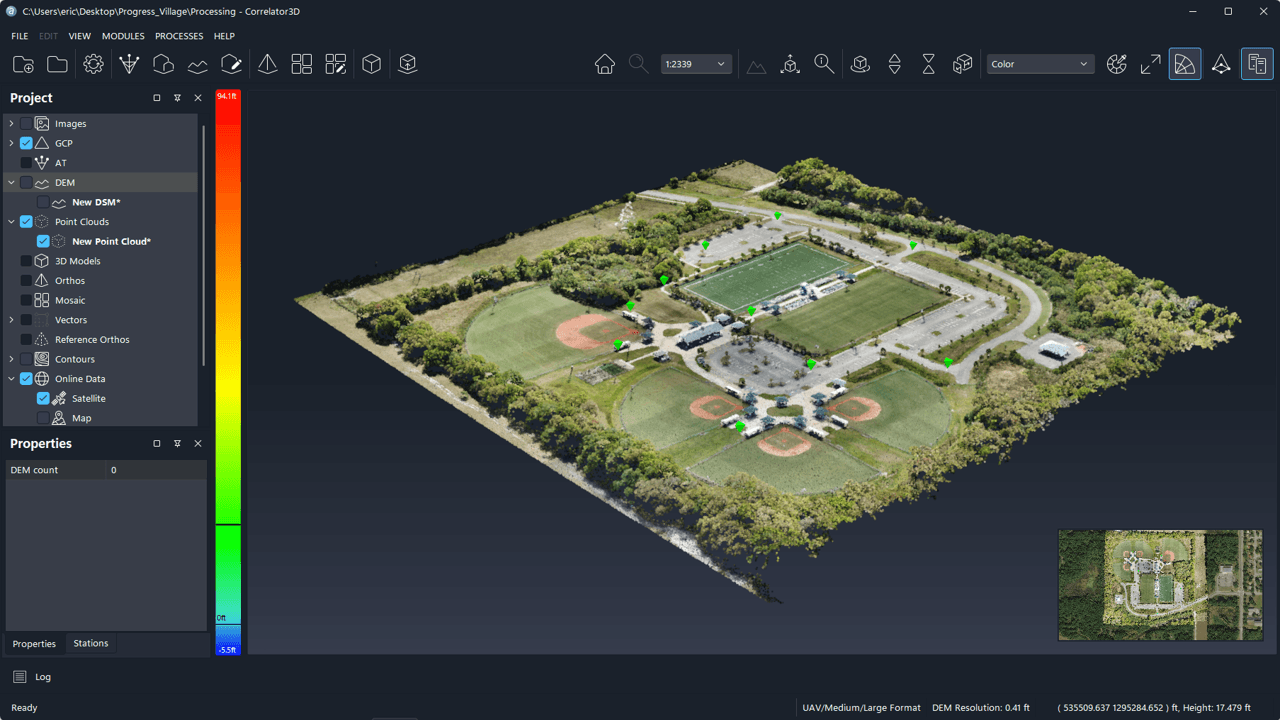 This week, SimActive launches v10 of Correlator3D: a new, feature-rich and redesigned version of SimActive’s innovative mapping platform.
This week, SimActive launches v10 of Correlator3D: a new, feature-rich and redesigned version of SimActive’s innovative mapping platform.
Continue reading below, or listen:
The company is also celebrating 20 years – a major achievement in any industry. DRONELIFE spoke with brothers Philippe and Louis Simard, the visionary team behind a mapping product used by most governments in the world, oil and gas conglomerates, and drone mapping operations of any size.
Philippe and Louis Simard aren’t twins, but they have followed each other’s footsteps closely. Both have graduate degrees in Computer Vision from Magill, studying in the same lab. It was in that lab that the Correlator3D platform was first conceived: a brand new idea for using the concepts of computer vision to generate accurate maps, quickly and easily.

Louis Simard is SimActive’s Chief Technology Officer, responsible for research and development. Louis describes how the brothers developed their first product.
“We were really young, right out of college – and starting a company was a dream,” Louis says. “We developed this technology to get 3D data from images. Now, everybody does that, but in 2003 it was really new. We weren’t even sure what we were going to do with it.”
The two found an application for their ideas in solving a significant problem: creating maps in the field, quickly and easily. Using faster algorithms, they were able to create detailed maps in a fraction of the usual processing time. It was an idea that met a major need for the Canadian army: in 2003, Canadian military agencies were mapping areas of Afghanistan to support US military operations.
“Using other products, it took [military agencies] months to train people, and then weeks to process the data,” Louis explains.
The brothers won a 5-year contract to develop a commercial software product with and for the agency. “We didn’t know much about the mapping business,” Louis admits. “Our first module was about 3D extraction, but the learning curve was pretty tough.” Not only did the team have to figure out the existing mapping processes to identify the pain points, 20 years ago ecosystem tools like computer hardware and storage were far less powerful than they are today. “It was so hard to get a powerful computer that could crunch the data,” said Louis.
By 2008, SimActive had an easy-to-use consumer product, which the Canadian army was happy to purchase. As the industry evolved, customers asked SimActive to meet new needs and new applications in mapping. “We just addressed them one by one, releasing a new module every year,” says Louis. “After about 7-10 years we had a really full suite.”

That step-by-step approach has influenced the development of the company ever since. “We’ve been profitable since day one,” says Philippe Simard, SimActive CEO. (“I make the promises, Louis keeps them,” jokes Philippe.) From a customer base made up almost entirely of huge mapping companies using manned aircraft, the product has evolved to accommodate data from multiple sources like satellites and drones. That flexibility has allowed SimActive to expand every year, self-funding and growing organically.
“Back in 2003 the statistics were strongly against us,” says Philippe. “Only 10 out of 300 startups would make it for the first year, and only 1 out of 300 would make it 5 years.”
Twenty years on, SimActive has beaten the odds, and both the product and the company have continued to grow. “Now, our revenue is almost doubling every year,” says Philippe. “The product has evolved quite a bit, and we’ve adapted our business models to accommodate many different clients – we can adapt to almost any need and any budget. And we have a strong network of resellers.”
Based in Montreal, SimActive now supports a remote workforce, which Philippe says has been a great success. “We’ve opened the doors to people internationally, which has made a big difference to our organization,” he says. “It allows us to support our clients almost 24/7, with all of the different time zones covered.”
Celebrating their 20 year anniversary, SimActive and the Simard brothers are looking forward to the next 20.
“Both Louis and I share the same vision,” says Philippe. “We’re having fun. We’re surrounded by seasoned, senior people who are super bright, they’re fun to work with.
“We love what we do. We want to keep pushing things.”
The New Release: Correlator 3D, v.10
“When it’s your birthday, you dress up – that’s what we did with our software,” says Louis. “We’ve completely redesigned the interface to give customers that ‘Wow’ factor when they start it.
“The last time we did that was 5 or 6 years ago,” he explains. “Changing everything in the interface is quite a challenge because you don’t want your legacy users to get lost. This is something we really wanted to make sure was really nice, but was still aligned with what we’ve done in the past.”

Behind the interface, the software has also been redesigned to be even easier and more precise.
“It’s an engine that we’ve been thinking about it and developing for a few year,” says Louis. “We’re using new techniques.”
“We extract high density point clouds where you can see very small details – in your final point cloud you’ll be able to actually read road signs,” he says. “Computers are improving all the time too, so we have access to all that power: but we still want people to be able to use their drone in the field and use their laptop.”

The improvement in hardware and ecosystem tools over the last few years has made new things possible. “Especially from a drone perspective, sensors have evolved quite a bit, including oblique imagery,” says Philippe. “The new version is all about being able to profit from all of this redundant information to come up with better results.”
“I think we’re setting a new standard in terms of point clouds for our users,” says Louis. “We’re miles from what we started with 15 years ago.”
Read more:
- Colorizing Lidar: SimActive and LiDARUSA Partner
- From the floor of Intergeo: Simactive, Mapping Spaces from Countries to Construction Sites
- SimActive and Phase One IIQ Integration: Faster Processing, Easier Data Management
- Are Drones Always the Best Tool for the Job? Beacon Aviation Reduces Mapping Costs with SimActive
- Drone Mapping in Construction: SimActive’s Correlator 3D in the Field in Texas
Miriam McNabb is the Editor-in-Chief of DRONELIFE and CEO of JobForDrones, a professional drone services marketplace, and a fascinated observer of the emerging drone industry and the regulatory environment for drones. Miriam has penned over 3,000 articles focused on the commercial drone space and is an international speaker and recognized figure in the industry. Miriam has a degree from the University of Chicago and over 20 years of experience in high tech sales and marketing for new technologies.
For drone industry consulting or writing, Email Miriam.
TWITTER:@spaldingbarker
Subscribe to DroneLife here.







[…] Möt de två bröderna bakom en visionär kartläggningsplattform: SimActive firar 20 år med en ny … […]